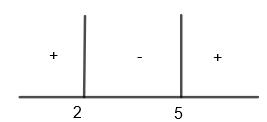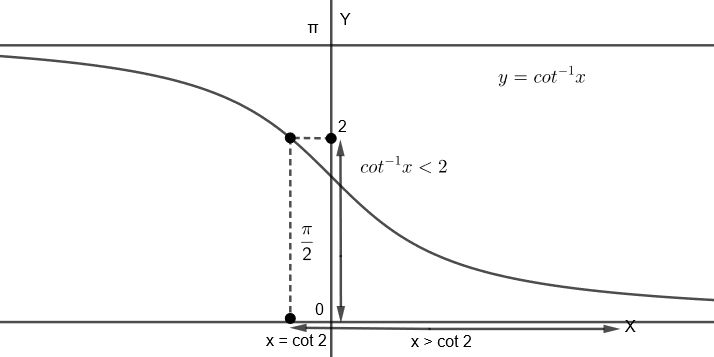
All x satisfy the inequality
\[{{\left( {{\cot }^{-1}}x \right)}^{2}}-7\left( {{\cot }^{-1}}x \right)+10>0\], lie in the interval
(a) \[\left( -\infty ,\cot 5 \right)\cup \left( \cot 4,\cot 2 \right)\]
(b) \[\left( \cot 5,\cot 4 \right)\]
(c) \[\left( \cot 2,\infty \right)\]
(d) \[\left( -\infty ,\cot 2 \right)\cup \left( \cot 5,\infty \right)\]
Answer
604.5k+ views
Hint: First of all, let \[{{\cot }^{-1}}x=y\] and resolve the equation into factors and find the range of \[y={{\cot }^{-1}}x\]. Then draw the graph of \[{{\cot }^{-1}}x\] to examine the values of x. Consider the domain and range of \[{{\cot }^{-1}}x\] properly for the correct values of x.
Complete step-by-step answer:
We are given that \[{{\left( {{\cot }^{-1}}x \right)}^{2}}-7\left( {{\cot }^{-1}}x \right)+10>0\].
Here, we have to find the values of x which satisfies this inequality.
Let us consider the inequality given in the question.
\[{{\left( {{\cot }^{-1}}x \right)}^{2}}-7\left( {{\cot }^{-1}}x \right)+10>0\]
Let us consider \[{{\cot }^{-1}}x\] to be y. By substituting \[{{\cot }^{-1}}x=y\] in the above inequality, we get,
\[{{y}^{2}}-7y+10>0\]
Here, we can write 7y = 5y + 2y. So, we get,
\[{{y}^{2}}-5y-2y+10>0\]
We can write the above inequality as,
\[y\left( y-5 \right)-2\left( y-5 \right)>0\]
By taking out (y – 5) common, we get,
\[\left( y-5 \right)\left( y-2 \right)>0\]

If y > 5, then (y – 5) > 0 and (y – 2) > 0.
So, we get (y – 5) (y – 2) > 0
Hence, y > 5 satisfies the inequality.
For example, let us take y = 7. By substituting y = 7, we get,
\[\left( 7-5 \right)\left( 7-2 \right)=\left( 2 \right)\left( 5 \right)=10>0\]
So, we get, \[y\in \left( 5,\infty \right)\].
If 2 < y < 5, then (y – 5) < 0 and (y – 2) > 0
So, we get (y – 5) (y – 2) < 0
Hence, 2 < y < 5 does not satisfy the inequality.
For example, let us take y = 3. By substituting y = 3, we get,
\[\left( 3-5 \right)\left( 3-2 \right)=\left( -2 \right)\left( 1 \right)=-2<0\]
So, we get, \[y\notin \left( 2,5 \right)\].
If y < 2, then (y – 5) < 0 and (y – 2) < 0.
So, we get, (y – 5) (y – 2) > 0
Hence y < 2 satisfies the inequality.
For example, let us take y = 0. By substituting y = 0, we get,
\[\left( 0-5 \right)\left( 0-2 \right)=\left( -5 \right)\left( -2 \right)=10>0\]
So, we get \[y\in \left( -\infty ,2 \right)\].
Hence, we get \[y\in \left( -\infty ,2 \right)\cup \left( 5,\infty \right)\].
We had assumed that \[{{\cot }^{-1}}x=y\], so by substituting \[y={{\cot }^{-1}}x\], we get,
\[{{\cot }^{-1}}x\in \left( -\infty ,2 \right)\cup \left( 5,\infty \right)\]
So, we get \[{{\cot }^{-1}}x<2\] and \[{{\cot }^{-1}}x>5\].
Now, we will see the graph of \[{{\cot }^{-1}}x\], that is

We know that the range of \[{{\cot }^{-1}}x\] is \[\left( 0,\pi \right)\], so it can’t be greater than 5.
Now, considering \[{{\cot }^{-1}}x<2\]
From the graph, we can see that, for \[{{\cot }^{-1}}x<2,\text{ }x>\cot 2\]
So, we get \[x\in \left( \cot 2,\infty \right)\].
Hence, the correct answer is option (c).
Note: After getting \[{{\cot }^{-1}}x\in \left( -\infty ,2 \right)\cup \left( 5,\infty \right)\], students often make this mistake of calculating x as \[x\in \left( -\infty ,\cot 2 \right)\cup \left( \cot 5,\infty \right)\] but this is wrong as we know that \[{{\cot }^{-1}}x\] could not be greater than 5 because its range is \[\left( 0,\pi \right)\]. Also for \[{{\cot }^{-1}}x\in \left( -\infty ,2 \right)\], \[x\in \left( \cot 2,\infty \right)\] not \[\left( -\infty ,\cot 2 \right)\]. So for inverse trigonometric function, it is advisable to first draw the graph and then only examine the values of x for the correct results.
Complete step-by-step answer:
We are given that \[{{\left( {{\cot }^{-1}}x \right)}^{2}}-7\left( {{\cot }^{-1}}x \right)+10>0\].
Here, we have to find the values of x which satisfies this inequality.
Let us consider the inequality given in the question.
\[{{\left( {{\cot }^{-1}}x \right)}^{2}}-7\left( {{\cot }^{-1}}x \right)+10>0\]
Let us consider \[{{\cot }^{-1}}x\] to be y. By substituting \[{{\cot }^{-1}}x=y\] in the above inequality, we get,
\[{{y}^{2}}-7y+10>0\]
Here, we can write 7y = 5y + 2y. So, we get,
\[{{y}^{2}}-5y-2y+10>0\]
We can write the above inequality as,
\[y\left( y-5 \right)-2\left( y-5 \right)>0\]
By taking out (y – 5) common, we get,
\[\left( y-5 \right)\left( y-2 \right)>0\]

If y > 5, then (y – 5) > 0 and (y – 2) > 0.
So, we get (y – 5) (y – 2) > 0
Hence, y > 5 satisfies the inequality.
For example, let us take y = 7. By substituting y = 7, we get,
\[\left( 7-5 \right)\left( 7-2 \right)=\left( 2 \right)\left( 5 \right)=10>0\]
So, we get, \[y\in \left( 5,\infty \right)\].
If 2 < y < 5, then (y – 5) < 0 and (y – 2) > 0
So, we get (y – 5) (y – 2) < 0
Hence, 2 < y < 5 does not satisfy the inequality.
For example, let us take y = 3. By substituting y = 3, we get,
\[\left( 3-5 \right)\left( 3-2 \right)=\left( -2 \right)\left( 1 \right)=-2<0\]
So, we get, \[y\notin \left( 2,5 \right)\].
If y < 2, then (y – 5) < 0 and (y – 2) < 0.
So, we get, (y – 5) (y – 2) > 0
Hence y < 2 satisfies the inequality.
For example, let us take y = 0. By substituting y = 0, we get,
\[\left( 0-5 \right)\left( 0-2 \right)=\left( -5 \right)\left( -2 \right)=10>0\]
So, we get \[y\in \left( -\infty ,2 \right)\].
Hence, we get \[y\in \left( -\infty ,2 \right)\cup \left( 5,\infty \right)\].
We had assumed that \[{{\cot }^{-1}}x=y\], so by substituting \[y={{\cot }^{-1}}x\], we get,
\[{{\cot }^{-1}}x\in \left( -\infty ,2 \right)\cup \left( 5,\infty \right)\]
So, we get \[{{\cot }^{-1}}x<2\] and \[{{\cot }^{-1}}x>5\].
Now, we will see the graph of \[{{\cot }^{-1}}x\], that is

We know that the range of \[{{\cot }^{-1}}x\] is \[\left( 0,\pi \right)\], so it can’t be greater than 5.
Now, considering \[{{\cot }^{-1}}x<2\]
From the graph, we can see that, for \[{{\cot }^{-1}}x<2,\text{ }x>\cot 2\]
So, we get \[x\in \left( \cot 2,\infty \right)\].
Hence, the correct answer is option (c).
Note: After getting \[{{\cot }^{-1}}x\in \left( -\infty ,2 \right)\cup \left( 5,\infty \right)\], students often make this mistake of calculating x as \[x\in \left( -\infty ,\cot 2 \right)\cup \left( \cot 5,\infty \right)\] but this is wrong as we know that \[{{\cot }^{-1}}x\] could not be greater than 5 because its range is \[\left( 0,\pi \right)\]. Also for \[{{\cot }^{-1}}x\in \left( -\infty ,2 \right)\], \[x\in \left( \cot 2,\infty \right)\] not \[\left( -\infty ,\cot 2 \right)\]. So for inverse trigonometric function, it is advisable to first draw the graph and then only examine the values of x for the correct results.
Recently Updated Pages
Master Class 11 Business Studies: Engaging Questions & Answers for Success

Master Class 11 Computer Science: Engaging Questions & Answers for Success

Master Class 11 Maths: Engaging Questions & Answers for Success

Master Class 11 Chemistry: Engaging Questions & Answers for Success

Master Class 11 Economics: Engaging Questions & Answers for Success

Master Class 11 Accountancy: Engaging Questions & Answers for Success

Trending doubts
What is meant by exothermic and endothermic reactions class 11 chemistry CBSE

1 Quintal is equal to a 110 kg b 10 kg c 100kg d 1000 class 11 physics CBSE

What are Quantum numbers Explain the quantum number class 11 chemistry CBSE

What is periodicity class 11 chemistry CBSE

Explain zero factorial class 11 maths CBSE

Mention the basic forces in nature class 11 physics CBSE




